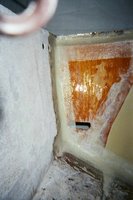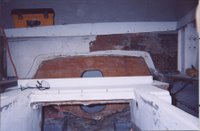



Well winter has set in full force. So
I'm changing gears and taking a break from boat building.
I decided to work on few small projects for the boat and go ahead get them out of the way. I bought this
old swim platform from a guy for $200.00 . I felt like I paid to much but a brand new one this size was between $800.00 and $900.00 . Its hard to tell but this swim platform looked like a piece of drift wood. Also five out of the six main slat
supports were rotten. I first started with a sander with 60 grit to see if I could bring out the color again. After I realized that it was going to clean up nicely I took it apart so I could really put a good sanding on it. I sanded first with 60 grit then 80 grit and finished with 120 grit. I was very pleased with way the teak came back, it has
beautiful grain lines. The main rails were in great shape, but I had to re-make all of the main support boards and ten of the rail spacers. This platform was off a boat that had a
straight transom, on a Formula the main part of the transom steps out from the rest of the transom. So I had to build two pieces for each end of the platform so the platform would hug the transom of the Formula without any large gaps. The last picture shows everything clamped together so I could make any final adjustments before I screw it together.




















































